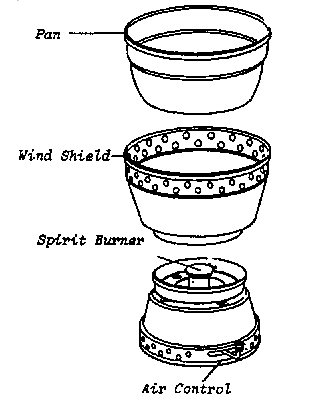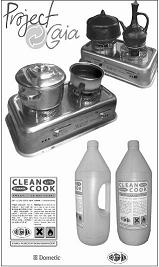Knowledge fuels change
For over a decade, Energypedia has shared free, reliable energy expertise with the world.
We’re now facing a serious funding gap.
Help keep this platform alive — your donation, big or small, truly matters!
Thank you for your support
Alcohol Stoves
Basics | Policy Advice | Planning | Designing and Implementing (ICS Supply)| Technologies and Practices | Designing and Implementing (Woodfuel Supply)| Climate Change
Cooking with Alcohol Stoves
A stove to burn alcohol fuels can be very simple. It can be made relatively cheaply in countries with industries producing articles such as aluminium pots, etc.
The main components of the burner are shown here[1]:
Experiences of Cooking with Ethanol Stoves
At present, ethanol stoves and fuel are consumed for household energy use in areas where they have been fostered and promoted by studies and commercial projects. The most documented ethanol stove model is the CleanCook Stove by CleanCook Sweden AB, which is produced in South Africa and promoted mainly by Project Gaia.
CleanCook Ethanol Stove
The "CleanCook" Stove is available as a single or double-burner model for households and institutions. It is made from aluminium or stainless steel. The CleanCook is a non-pressurized alcohol stove with a refillable fuel canister of a capacity of 1,2 liters.[2] The canister contains a porous fiber that adsorbs alcohol and retains it in a manner that prevents spills, leaks, fires and explosions.[3] The power output per burner is rated at 1.8 kW at maximum heat, allowing for a cooking time of 4-5 hours. It can burn ethanol and methanol.[2]
Up to now, 55,000 cleancook stoves have been provided, mainly in Africa.[4]
Project Gaia and Gaia Associations have achieved an excellent history of safety by employing stringent training protocols for staff and end users. The cost of the CleanCook stove models range from $57-110 USD[5]. Project Gaia employs various financing schemes including sustainable loan programs and carbon finance to deliver affordable alcohol stoves and fuel to energy poor households.[6]
Project Gaia and its Ethiopian sister organization, Gaia Association, have lab and field tested alcohol stoves since 2005. To date, alcohol stoves have been used by households in Ethiopia, Nigeria, South Africa, Malawi, Madagascar, Mozambique, Vietnam, Brazil and Haiti. Click here to access country study/project reports. The largest number of households using alcohol stoves is in the UNHCR refugee camps near Jijiga, Eastern Ethiopia where more than 4,000 households rely on the CleanCook stove and ethanol fuel as their main source of energy. The UNHCR now aims to scale up to provide ethanol cookstoves and fuel to up to 27,678 households by 2017.[7]
Project Gaia currently leads four community-based, small-scale ethanol distillation projects in Ethiopia. Also in Brazil and Haiti microdistillery projects are being implemented. These projects aim to allow communities to produce clean cooking fuel using local feedstocks, simultaneously adding value to agricultural markets by taking advantage of co-products of the distillation process[8].
Further Information
- HEDON Household Energy Network: This network provides information on all aspect of ethanol as a household fuel
- The ‘Cookstove Fuels’ section of the Global Alliance for Clean Cookstoves
- Project Gaia homepage
- The Bioenergy Wiki for ‘Ethanol’
- Ten Years in Ethiopia: A look back at the last decade. Project Gaia (January 2015).
- link zum fuel Kapitel CEC
References
- ↑ http://www.hedon.info/BP33_EthanolStovesForMauritius?bl=y
- ↑ 2.0 2.1 http://cleancook.com/productsstove-sales/
- ↑ https://en.wikipedia.org/wiki/Project_Gaia#The_CleanCook_Stove
- ↑ http://cleancook.com/about-us/
- ↑ http://www.projectgaia.com/index.php
- ↑ http://www.hedon.info/View+Stove?itemId=8969
- ↑ http://us4.campaign-archive2.com/?u=541b5acf6da7c1b89cf4193b7&id=849ff674b0&e=da11811f02
- ↑ http://www.projectgaia.com/index.php
Cooking with Plant Oils
Plant oil fuels pose the challenge that they have a high viscosity and only ignite at temperatures above 200° Celsius. Depending on the oil type, simple wick-stoves are not suitable and sometimes preheating of the oil with another fuel that burns at lower temperatures is needed. Pressurizing enhances the performance and power-output, but adds more challenges and cost to the stove.
Plant oil differs from other liquids when used for cooking. Below are some advantages and disadvantages.
Advantages:
- Safety: Plant oil is has a high viscosity and a higher flame point as compared to kerosene. For the user, this has the advantage of safety (it does not ignite spontaneously and is not so explosive when spilled).
- Smell: Most plant oils also do not emit undesirable odours (it does not smell as intensive as kerosene).
- Fast cooking: Plant oil has a high energy content (only 5% less than kerosene). Hence it produces a powerful flame if used in a pressurized stove. Cooking large quantities can be done quickly.
Disadvantages:
- Pre-heating: The advantages on safety and smell come at the expense that it usually needs to be preheated with another fuel (e.g. ethanol or methanol) in order to be ignited. This pre-heating is another cost factor and it consumes time.
- Simmering: The linked disadvantage is that it is difficult to simmer: in a pressurized regulating the plant-oil supply down for small heat poses a challenge.
- Cleaning: Plant oils contain fiber, the amount of which depends on the kind of oil and the quality of the filter method applied. As the oil is burned as gas, the fiber remains behind and tends to clog the burner (depending on the type of stove). This requires regular cleaning of stove and nozzles.
- Noise: if burned in a pressurized system, cooking on plant oil can be quite noisy. It requires muffling of the sound.
Experiences of Cooking with Plant Oil
During the last decades, projects have sought to design household appliances for cooking and heating that use plant oil.
Until recently, none of them got beyond the test phase. Some of the reasons for the past failure of plant oil cookers are:
- Plant oil cookers have a rather complicated design which is not easy to construct
- They may require ongoing maintenance
- Production of plant oil is labour-intensive and expensive
- The use of some plant oils as fuels competes with other uses, such as food crops, soap production etc., which are more profitable
- In most cases, production of fuelwood is much easier and much cheaper than production of plant oil
Protos the Plant Oil Stove
The University Hohenheim (Germany), in cooperation with Bosch and Siemens Home Appliances Group (BSH), developed protos the plantoilcooker. The basic idea was to develop a cookstove that can use a variety of plant oils; even recycled and filtered oil previously used for frying.
Field tests in the Philippines and in Tanzania have shown that households and small enterprises such as restaurants, that were previously cooking on 3-stone fires, can handle the Protos-stove. People stated that they enjoyed the comfort of cooking and said it was like cooking on gas, even if LPG was not available. Based on observations from the field tests, BSH developed a 'second generation' of the protos plantoilstove technology to increase efficiency, reducing noise, cleaning time and the cost of production.[1] The serial production was launched in May 2010 in Indonesia. Initial costs were considered to be around US$40 - 42, at a production rate of around 25,000-50,000 units in 2010.[2]
However, in 2012, BSH decided to conclude the Protos plant oil cooker project and to discontinue series production of the stove in Indonesia. The main reasons were as follows:[3]
- The stove was required to be of a high quality, safe and as easy as possible to use. Equally, however, it had to be cheap enough for people in developing countries to be able to afford it. The low purchasing power of the potential users had limited the use of the stove to a few individual projects.
- Plant oil cookers require a lot more cleaningn and maintenance than kerosene stoves as plant oil leaves residue in the burner when it evaporates.
- Due to the physical properties of plant oil the stove is technically complex. All varieties of plant oil have an extremely high flash point, which means that plant oil stoves require much higher operating temperatures and a longer pre-heating process than conventional stoves burning fossil fuel.
- No established market for sustainably cultivated plant oil in Indonesia.
- BSH faced serious difficulties in setting up a supply chain for sustainable cultivated plant oil.
BSH has freed all patents associated with the plant oil cooker technology. Construction plans, introduction guidelines and other technical information is available at: http://www.bsh-group.com/index.php?127656
Further Information
- Stove by BSH (protos). Article on energypedia.
- A breath of fresh air: Protos the plant oil stove. By Samuel N. Shiroff, in: Boiling Point 56, 2009.
- BSH: Protos. The Plant Oil Stove.
References
- ↑ https://energypedia.info/wiki/Stove_by_BSH_%28protos%29
- ↑ http://stoves.bioenergylists.org/taxonomy/term/1687
- ↑ Protos Plant Oil Cooker Project to Conclude. http://www.bsh-group.com/index.php?109906
Further Information on Plantoil
- Jatropha curcas L. in Africa. Assessment of the impact of the dissemination of “the Jatropha System” on the ecology of the rural area and the social and economic situation of the rural population (target group) in selected countries in Africa, by Reinhard K. Henning (2006).
This paper gives a good overview on production of the Physic Nut in Africa and the variety of its use. Special attention is paid the use of plant oil as a fuel. An overview of existing cooker models is given including technical details. - Jatropha System.htm The Jatropha System- An Integrated Approach of Rural Development in Tropical & Subtropical Countries.
The very comprehensive homepage provides a good overview of the role of Jatropha in different countries, technical aspects of oil extraction, different cooker models developed so far, a selection of projects working in the field of Jatropha use as well as a large amount of literature on the issue.
References
This article was originally published by GIZ HERA. It is basically based on experiences, lessons learned and information gathered by GIZ cook stove projects. You can find more information about the authors and experts of the original “Cooking Energy Compendium” in the Imprint.






















